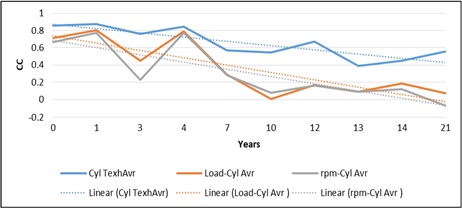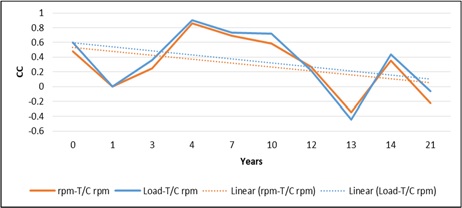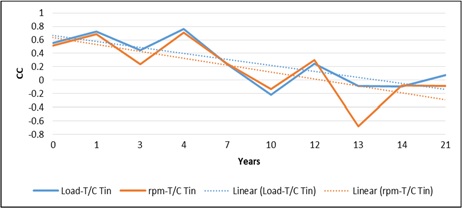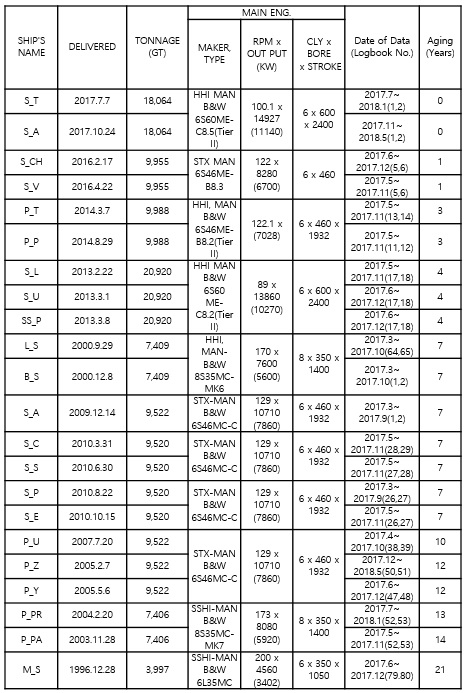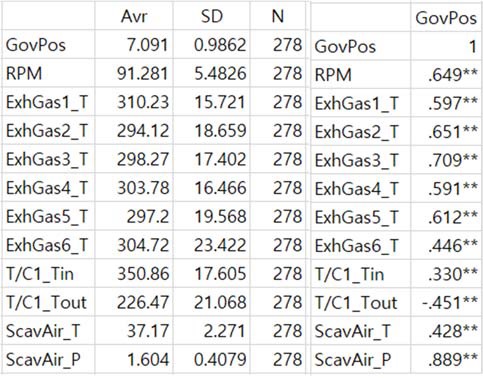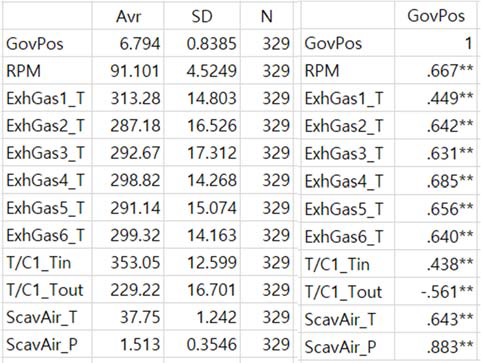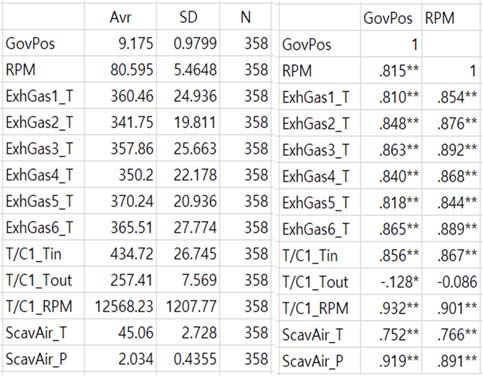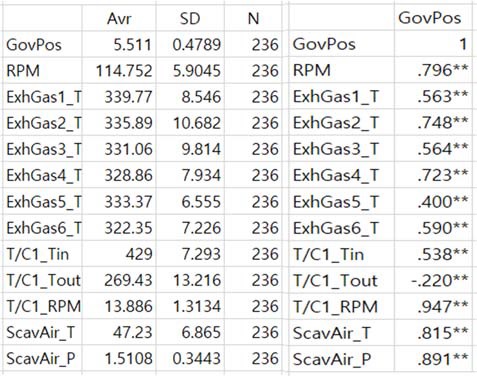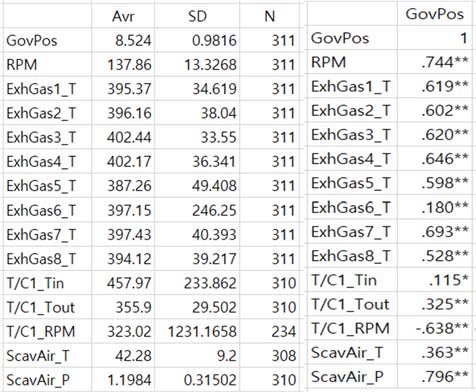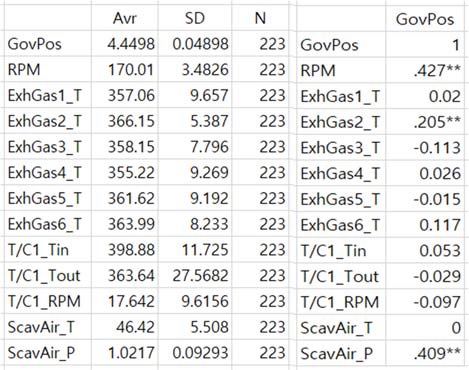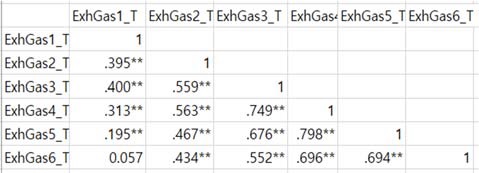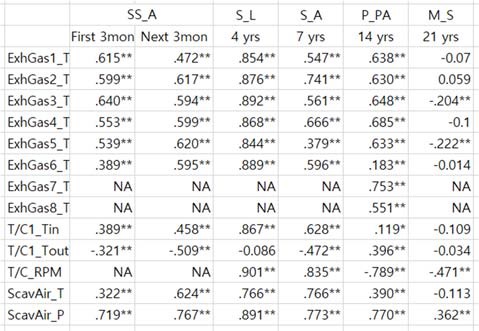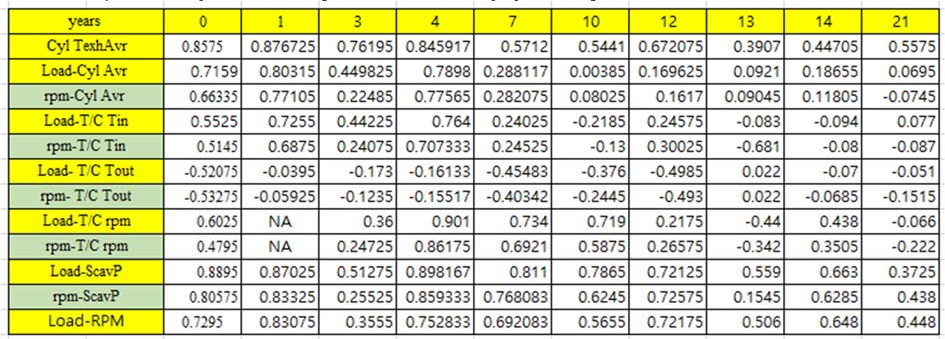
A study on the correlation coefficients of exhaust gas temperature at the main engine cylinder of middle-size container ships for fault detection
Copyright © The Korean Society of Marine Engineering
This is an Open Access article distributed under the terms of the Creative Commons Attribution Non-Commercial License (http://creativecommons.org/licenses/by-nc/3.0), which permits unrestricted non-commercial use, distribution, and reproduction in any medium, provided the original work is properly cited.
Abstract
Recently, smart and autonomous ships have become hot issues at the International Maritime Organization (IMO) and ship building industry. Smart ships will be completed in the near future because the environmental requirements of the IMO, such as the reduction of greenhouse gas, carbon particle, and NoX emissions, have become increasingly severe. The ship building industry has attempted to solve optimal and economic ship operation problems and comply with these requirements with the digitalization of ship operations using information and communication technology. One of the most important functionalities for smart ships is fault detection and diagnosis system for machineries, especially the main engines and dynamo engines. Major machineries in engine rooms are composed of diesel engines, heat exchangers for diesel engine operations, and pumps and motors for the operation of heat exchangers. To detect faults in running machineries, it is necessary to treat data and detect faults in real time. Recently, several methods using artificial intelligence have been suggested, but their implementations onboard have some limitations. In this study, a statistical method utilizing Pearson correlation coefficient (CC) is used to detect faults in running machines without additional sensors. This study analyzes 6 months’ worth of running data of 24 middle-size ships to analyze the CCs of various items in the main diesel engine using IBM SPSS Statistics. The number of used data is over 10,000. The set of ships includes a maiden voyage ship, 10 to 30 voyages, and over 40 voyages to investigate the changes in CCs for each item depending on the age of the ship. The duration of one voyage in this shipping company is almost under 2 weeks. This paper proposes the CC level of each item in the main diesel engine for the detection of faults.
Keywords:
Correlation coefficient, Statistical analysis, Fault detection of the combustion engine, Using ship operational big data, Without additional sensors1. Introduction
Fault diagnosis is the detection of faults in a running machine. Almost all faults in the diesel engine result from the combustion condition inside the cylinder. An incomplete combustion inside the cylinder causes late combustion, raises the temperature of exhaust gas, and reduces power. It also produces carbon deposits on the piston and causes jammed piston rings and hence damages. Thus, exhaust gas temperature can be a significant parameter to observe the combustion condition inside the cylinder. Under the assumption that the combustion condition in the cylinder may be the same as that in an engine, correlation coefficients (CCs) between cylinders will also be similar. If the CCs of the cylinders are quite different, then an abnormal combustion in a cylinder may occur. Combustion gas flows to the turbocharger (T/C) and generates scavenge air. Thus, if CCs are investigated for the T/C and scavenge air pressure, then the faults of the T/C and blower can be detected. These kinds of methods, which attempt to determine faults through the investigation of related CCs, can be extended to heat exchangers, motors, and pumps to detect the faults of a system without any additional sensors. If abnormal CCs are detected in the system, then they are compared with the CCs of other items in the same system to verify the faults. To apply this method, the level of CC for each item in the system should be known in a sister or similar ship type and should be classified according to the ship’s age. This study corroborates the results of previous studies [1]-[5] through an application of the method to many ships with different ages and extended data. This study collected over 10,000 operational data covering 6 months from the engine logbooks of 24 ships, whose details are summarized in Table 1. As shown in Table 1, the samples are composed of several sister ships and properly aged ships to identify the characteristics and changes in the CCs of the various items of the main engine. The ships’ ages are spread out evenly from 0 to 4 years, 7 years, and over 10 years.
2. Relationship of CCs with specific variables in the main diesel engine
2.1 Relationship of CCs with the load
The load is indicated by the governor position. When the governor is in a high position or the load is high, the fuel rack is pushed to put ample fuel oil into the cylinder and the power is increased. The exhaust gas of each cylinder flowing into the T/C generates scavenge air in the blower connected to the turbine. Thus, the load is interrelated with the scavenge air pressure, which scavenges fresh air inside the cylinder for the next combustion. The exhaust gas temperature of the cylinder is also interrelated with the T/C inlet and outlet temperatures. However, the degree of relationships between the items is still unknown. Hence, it is very important to determine the relationships between the items under a machine’s good condition. If we identify such relationships under a machine’s good condition, then fault detection can be easily conducted through a comparison and changes in the relationship can be detected. Table 2 shows the CCs of each item in SS_A ship, of which data are collected during a maiden voyage. It also shows the descriptive statistics and CCs of the load of SS_A during the maiden voyage. In Table 2, GovPos means the governor position or load, SD is the standard deviation, and N is the number of data.
The descriptive statistics and CCs of the load presented in Table 2 can be referred as a sample because they are the index values of the first 3 months’ operation. The CCs of the load with revolution per minute (RPM) and with T/C outlet temperature are 0.649 and −0.451, respectively, which means that the load increases and then the T/C outlet temperature tends to decrease to create more scavenge air with the T/C power up by a high heat drop. The mean of CCs for the load in each cylinder is 0.601, which is highly related to the significance level of 0.01. The CC of the load with scavenge air pressure is 0.889.
Table 3 shows the CCs of the next 3 months’ operating conditions with different draft and sea conditions.
Comparing Tables 2 and 3, there are some differences in the values, but the tendency of negative CC is similar in the CC of the load with T/C outlet temperature.
Ship S_L (age = 4 years) is bigger and older than ship SS_A. Table 4 shows those of ship S_L. The CC of the load with an RPM is 0.815 and −0.128 with T/C outlet temperature. The mean of CCs for the load in each cylinder is 0.8407. The CC of the load with scavenging air pressure is 0.919 and with T/C RPM is 0.932.
Table 5 shows the CCs of the load of ship S_A (age = 7 years). The CCs of the load with RPM and with T/C outlet temperature are 0.796 and −0.220, respectively. The mean of CCs for the load in each cylinder is 0.598. The CCs of the load with scavenge air pressure and T/C RPM are 0.891 and 0.947, respectively. Even though the ship’s age is 7 years, the operation condition of the main engine is still well maintained.
However, the manner by which the CCs of the load change when the ship’s age is over 10 years is still unknown. Accordingly, Table 6 shows the CCs of the load of ship P_PA, whose age is 14 years.
The CCs of the load with RPM and T/C outlet temperature are 0.744 and 0.325, respectively. The mean of CCs for the load in each cylinder is 0.5608. The CCs of the load with scavenge air pressure and T/C RPM are 0.796 and −0.638, respectively. Unexpectedly, the CC of the load with T/C RPM is negative and that with T/C outlet temperature is 0.325, which is negative in other cases, and that with T/C inlet temperature is 0.115, which is very small in comparison with other cases. We can attribute these results to some resistances in the T/C or blower, a clogged filter in the blower, a clogged diffuser in the T/C, or the bearing of the T/C.
Furthermore, the running hours of the T/C bearing and air filter of the blower with different pressures should be checked, among others. We should also consider the CCs of the load with the exhaust gas temperature of cylinder 6, which has a relatively low value in comparison with other cylinders.
The standard deviation of cylinder 6 is also bigger (246.25) than others, which means that the combustion situations (including late combustion) inside this cylinder are not even. The fuel valve may also be doubted in this case. In this case, the CCs between the exhaust gas temperatures of each cylinder are examined, as shown in Table 7.
Those of cylinder 6 are very low in comparison with others. We can present some problems of the combustion in cylinder 6.
The running hours for the fuel valve of cylinder 6 and other symptoms should be examined.
How is it for ship M_S, which is 21 years old?
Table 8 shows the descriptive statistics and CCs of the load with the exhaust gas temperatures of each cylinder for M_S.
The CCs of the load with RPM and T/C outlet temperature are 0.427 and −0.029, respectively. The mean of the CCs for the load in each cylinder is 0.04. The CCs of the load with the scavenge air pressure and T/C RPM are 0.409 and −0.097, respectively. The CCs of the load in the exhaust gas temperatures of cylinders 3 and 5 are negative, and those of others are very small positive in comparison with young or other ships. These findings mean that the combustion states of all cylinders may involve incomplete combustion. Particularly, the CC of the load with T/C RPM is negative, and the scavenge air pressure is almost approximately 1.0 kg/cm2. These factors result in insufficient scavenge air and may not completely refresh the cylinder with fresh air, hence resulting in an incomplete combustion. Table 9 shows the CCs between the cylinders for this ship.
As shown in Table 9, the CCs of cylinder 1’s exhaust gas temperature are low relatively. Thus, cylinder 1’s combustion may be one of the reasons for these phenomena.
2.2 Relationship of the CCs with the RPM
RPM is closely related with the engine operating condition, so the relationship of the CCs of RPM with other important parameters of engine should be investigated. Table 10 shows the CCs of the RPM in each exhaust gas temperature of the cylinder.
NA in the table means no data or not applicable. As shown in Tables 2-10, the CCs of RPM and load with T/C outlet temperature are negative. If the engine condition is getting worse, then these CCs are approaching zero and, in severe cases, become slightly positive. Hence, the T/C power is reduced, resulting in the lack of scavenge air.
The CCs of ship SS_A, which is the maiden voyage, can be used as references for the criterion even though the load is under 70% because the load of the maiden voyage is maintained around 70% of the full load for domestication of the engine. In Table 10, we can determine which cylinder should be closely observed, for example, cylinder 6 in the first 3 months of ship SS_A, cylinder 5 in ship S_A, and cylinder 6 in ship P-PA. In the case of ship M_S, the whole combustion in each cylinder should be considered because all CCs of the RPM with the cylinder exhaust gas temperature and the whole T/C relation are close to zero and, in severe cases, negative. Furthermore, there may be severe problems in the cylinder liner, piston rings, and T/C. Conversely, in Table 9, the CCs between the exhaust gas temperature of the cylinder are relatively good except for cylinder 1. Hence, the combustion conditions in all cylinders are similar, and the condition of the fuel valves may be good. Nonetheless, more severe principal problems should be considered.
3. Changes in CCs due to aging
3.1 CCs with important items
It is important to determine the changing ranges of CCs for each item to detect faults in the components of the diesel engine, such as CCs of the load, RPM, and CCs between the cylinders. This study investigates the changes in CCs for each important item according to the aging of ships to detect faults, as shown in Table 11.
Combustion inside the cylinder is one of the significant parameters for engine performance and causes faults in diesel engine. Scavenge air pressure is an important factor to charge cylinder with fresh air after combustion. These are all connected combustion inside the cylinder and exhaust gas temperature of the cylinder. Table 11 shows all the averages of CCs with the load and RPM for scavenge air pressure, T/C, and cylinders according to the ship’s age.
3.2 Trend of CC changes of important items with the aging of the ship
Figure 1 shows the changing trend of the CCs of scavenge air pressure with the load and RPM based on Table 11. Because of the small number of ships available in every age, particularly 3 and 13 years old (Figure 1), the CCs are far away from the linearized curve, but Figure 1 shows a reasonable trend.
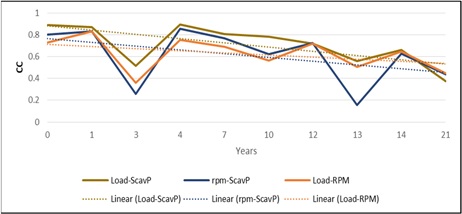
CC changing trend of scavenge air pressure with the load and RPM and those of the load and RPM with aging
Figure 2 shows the CC trend of the cylinder and those of the load and RPM. The CCs between the cylinders are very high even though the ships are old, as shown in Figure 2
Figure 3 shows the CC trend of the T/C outlet temperature with the load and RPM. As mentioned in the previous chapter, the CCs of the T/C outlet temperature with the load and RPM are negative. These findings indicate the output of T/C. If CC is a large negative number, when the load and RPM are increased, then T/C outlet temperature is decreased, so the T/C output becomes bigger and can make scavenge air pressure high and supply more fresh air into the cylinder.
Figure 4 shows the CC changing trend of T/C RPM with the load and RPM with the age of the ship. Figure 5 shows the CC changing trend of T/C inlet temperature with the load and RPM.
These trends can be used and referred as criterions for fault detection by CCs.
4. Conclusions
Diagnosis systems for machineries are core technologies in smart and autonomous ships. Before diagnosing machineries, the parts of machineries with faults should be detected. In some parts of machineries, faults can be detected by checking over or below the predefined critical value. However, several factors may not be considered in the detection of faults with the predefined limit values. Particularly, in the case of diesel engine, although the combustion condition inside the cylinder is slightly out of the normal, it is not considered a fault. The power source of diesel engine is the fuel combustion inside cylinder. The combustion condition of the fuel inside the diesel engine depends on many conditions, such as the load, RPM, temperature, and pressure related to combustion process.
Many methods have been used to detect faults in the diesel engine. Recently, methods using artificial intelligence and big data have been proposed, but it is very difficult to consider all cases and conditions. Thus, this study proposed the use of CCs of important items that are closely related to one another.
This study investigated 24 ships with similar sizes and operation patterns but with different ages, from a newly built ship to a 21-year-old ship. The CCs of the important and sensitive parameters in detecting the fault of diesel engine are investigated using 6 months’ worth of operational data, which total to over 10,000 data. This paper proposed the changing trends of important CCs to detect faults and draw criteria that can be used in deciding faults with the ship’s age. The detected items can be compared with other CCs of related items. After fixing the faults, they can be diagnosed through a CC comparison. Accordingly, the causes behind the faults, their solutions, and other maintenance suggestions can be recommended.
Acknowledgments
This research was financially supported by the Ministry of Trade, Industry and Energy (MOTIE) and Korea Institute for Advancement of Technology (KIAT) through the National Innovation Cluster R&D Program (P0006893, A Development of Predictive Maintenance System for Core Facilities in Maneuvering Vessel).
Author Contributions
Conceptualization, Y. H. Yu; Methodology, B. S. Kim and H. G. Hwang; Software, Y. H. Yu; Formal Analysis, Y. H. Yu; Investigation, H. G. Hwang; Resources B. S. Kim and H. G. Hwang; Data curation B. S. Kim and H. G. Hwang; Writing-Original Draft Preparation, Y. H. Yu; Writing-Review & Editing, Y. H. Yu; Visualization, B. S. Kim and H. G. Hwang; Supervision, Y. H. Yu; Project Administration, Y. H. Yu; Funding Acquisition, Y. H. Yu.
References
- Y. Kim, H. Oh, and Y. Yu, “The fault diagnosis method of diesel engines using a statistical analysis method,” Journal of the Korean Society of Marine Engineering, vol. 30, no. 2, pp. 247-252, 2006 (in Korean).
- Y. Kim, H. Oh, and Y. Yu, “The development of diesel engine room fault diagnosis system using a correlation analysis method,” Journal of the Korean Society of Marine Engineering, vol. 30, no. 2, pp. 253-259, 2006 (in Korean).
- Y. Kim, The Fault Diagnosis and Prediction System of Marine Diesel Engines Using a Statistical Analysis Method, Ph. D. Dissertation, Department of Control Instrument Engineering, Korea Maritime & Ocean University (KMOU), Korea, 2005 (in Korean).
- Y. Yu, S. Mo, and S. R. Baloch, “A study on the real time fault detection and diagnosis system for onboard engine room,” ISMT2019 (International Symposium on Marine Engineering and Technology 2019), p. 75, 2019.
-
Y. Yu and S. R. Baloch, “Real time fault detection and diagnosis system for onboard engine room,” Journal of the Korean Society of Marine Engineering, vol. 43, no. 10, pp. 810-815, 2019.
[https://doi.org/10.5916/jkosme.2019.43.10.810]



